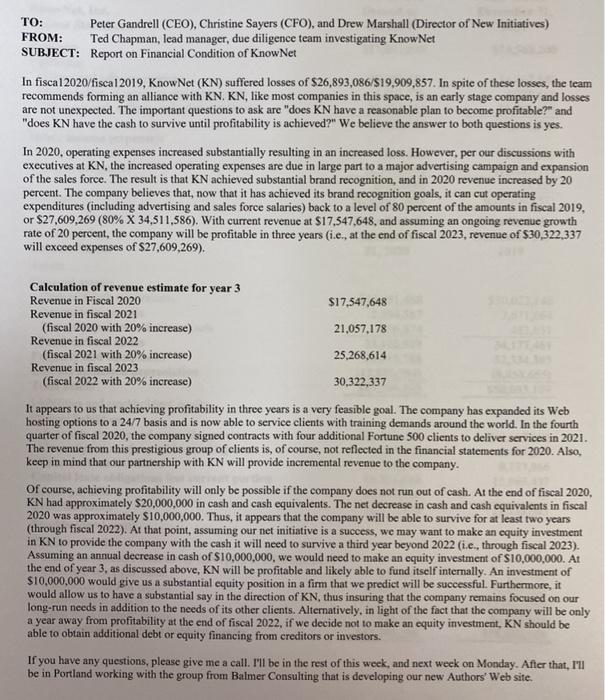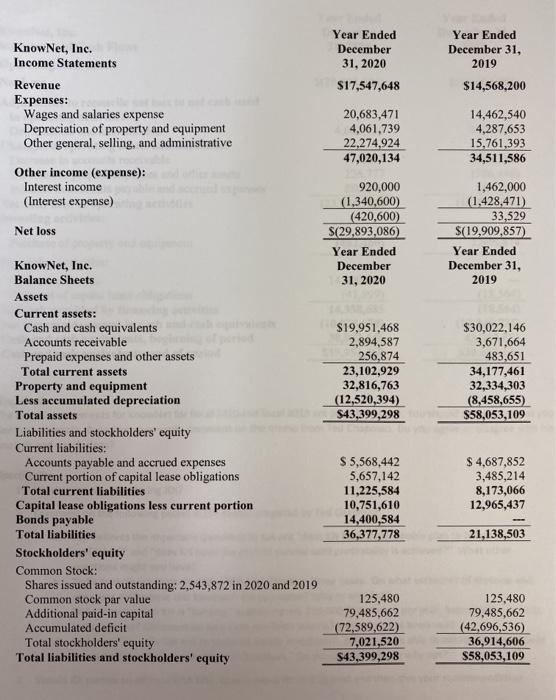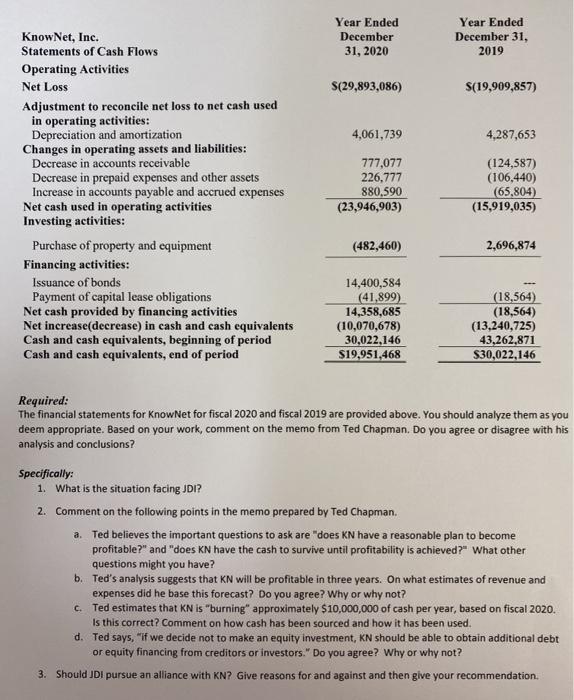Answered step by step
Verified Expert Solution
Question
1 Approved Answer
Jordan Williams, Inc. In fiscal 2020/fiscal 2019, KnowNet (KN) suffered losses of $26,893,086/$19,909,857. In spite of these losses, the team recommends forming an alliance with
Jordan Williams, Inc. 


TO: Peter Gandrell (CEO), Christine Sayers (CFO), and Drew Marshall (Director of New Initiatives) FROM: Ted Chapman, lead manager, due diligence team investigating Know Net SUBJECT: Report on Financial Condition of KnowNet In fiscal 2020/fiscal 2019, Know Net (KN) suffered losses of $26,893,086/519,909,857. In spite of these losses, the team recommends forming an alliance with KN. KN, like most companies in this space, is an early stage company and losses are not unexpected. The important questions to ask are "does KN have a reasonable plan to become profitable?" and "does KN have the cash to survive until profitability is achieved?" We believe the answer to both questions is yes. In 2020, operating expenses increased substantially resulting in an increased loss. However, per our discussions with executives at KN, the increased operating expenses are due in large part to a major advertising campaign and expansion of the sales force. The result is that KN achieved substantial brand recognition, and in 2020 revenue increased by 20 percent. The company believes that, now that it has achieved its brand recognition goals, it can cut operating expenditures (including advertising and sales force salaries) back to a level of 80 percent of the amounts in fiscal 2019, or $27,609,269 (80% X 34,511,586). With current revenue at $17.547,648, and assuming an ongoing revenue growth rate of 20 percent, the company will be profitable in three years (i.e., at the end of fiscal 2023, revenue of $30,322,337 will exceed expenses of $27,609,269). Calculation of revenue estimate for year 3 Revenue in Fiscal 2020 $17.547,648 Revenue in fiscal 2021 (fiscal 2020 with 20% increase) 21,057,178 Revenue in fiscal 2022 (fiscal 2021 with 20% increase) 25,268,614 Revenue in fiscal 2023 (fiscal 2022 with 20% increase) 30,322,337 It appears to us that achieving profitability in three years is a very feasible goal. The company has expanded its Web hosting options to a 24/7 basis and is now able to service clients with training demands around the world. In the fourth quarter of fiscal 2020, the company signed contracts with four additional Fortune 500 clients to deliver services in 2021. The revenue from this prestigious group of clients is, of course, not reflected in the financial statements for 2020. Also, keep in mind that our partnership with KN will provide incremental revenue to the company. Of course, achieving profitability will only be possible if the company does not run out of cash. At the end of fiscal 2020, KN had approximately $20,000,000 in cash and cash equivalents. The net decrease in cash and cash equivalents in fiscal 2020 was approximately $10,000,000. Thus, it appears that the company will be able to survive for at least two years (through fiscal 2022). At that point, assuming our net initiative is a success, we may want to make an equity investment in KN to provide the company with the cash it will need to survive a third year beyond 2022 (i.c., through fiscal 2023). Assuming an annual decrease in cash of $10,000,000, we would need to make an equity investment of $10,000,000. At the end of year 3, as discussed above, KN will be profitable and likely able to fund itself internally. An investment of $10,000,000 would give us a substantial equity position in a firm that we predict will be successful. Furthermore, it would allow us to have a substantial say in the direction of KN, thus insuring that the company remains focused on our long-run needs in addition to the needs of its other clients. Alternatively, in light of the fact that the company will be only a year away from profitability at the end of fiscal 2022, if we decide not to make an equity investment, KN should be able to obtain additional debt or equity financing from creditors or investors. If you have any questions, please give me a call. I'll be in the rest of this week, and next week on Monday. After that, I'll be in Portland working with the group from Balmer Consulting that is developing our new Authors' Web site. Year Ended December 31, 2019 $14,568,200 14,462,540 4,287,653 15,761,393 34,511,586 1,462,000 (1,428,471) 33,529 $(19,909,857) Year Ended December 31, 2019 Year Ended KnowNet, Inc. December Income Statements 31, 2020 Revenue $17,547,648 Expenses: Wages and salaries expense 20,683,471 Depreciation of property and equipment 4,061.739 Other general, selling, and administrative 22,274,924 47,020,134 Other income (expense): Interest income 920,000 (Interest expense) (1,340,600) (420,600) Net loss S(29,893,086) Year Ended KnowNet, Inc. December Balance Sheets 31, 2020 Assets Current assets: Cash and cash equivalents $19,951,468 Accounts receivable 2,894,587 Prepaid expenses and other assets 256,874 Total current assets 23,102,929 Property and equipment 32,816,763 Less accumulated depreciation (12,520,394) Total assets S43,399,298 Liabilities and stockholders' equity Current liabilities: Accounts payable and accrued expenses S 5,568,442 Current portion of capital lease obligations 5,657,142 Total current liabilities 11,225,584 Capital lease obligations less current portion 10,751,610 Bonds payable 14,400,584 Total liabilities 36.377,778 Stockholders' equity Common Stock: Shares issued and outstanding: 2,543,872 in 2020 and 2019 Common stock par value 125.480 Additional paid-in capital 79,485,662 Accumulated deficit (72,589,622) Total stockholders' equity 7,021,520 Total liabilities and stockholders' equity S43,399,298 $30,022,146 3,671,664 483,651 34,177,461 32,334,303 (8,458,655) S58,053,109 $ 4,687,852 3,485,214 8,173,066 12,965,437 21,138,503 125,480 79,485,662 (42,696,536) 36,914,606 S58,053,109 Year Ended December 31, 2020 Year Ended December 31, 2019 S(29,893,086) S(19,909,857) 4,061,739 4,287,653 KnowNet, Inc. Statements of Cash Flows Operating Activities Net Loss Adjustment to reconcile net loss to net cash used in operating activities: Depreciation and amortization Changes in operating assets and liabilities: Decrease in accounts receivable Decrease in prepaid expenses and other assets Increase in accounts payable and accrued expenses Net cash used in operating activities Investing activities: Purchase of property and equipment Financing activities: Issuance of bonds Payment of capital lease obligations Net cash provided by financing activities Net increase(decrease) in cash and cash equivalents Cash and cash equivalents, beginning of period Cash and cash equivalents, end of period 777,077 226,777 880,590 (23,946,903) (124,587) (106,440) (65,804) (15,919,035) (482,460) 2,696,874 14,400,584 (41,899) 14,358,685 (10,070,678) 30,022,146 $19,951,468 (18,564) (18,564) (13,240,725) 43,262,871 $30,022,146 Required: The financial statements for KnowNet for fiscal 2020 and fiscal 2019 are provided above. You should analyze them as you deem appropriate. Based on your work, comment on the memo from Ted Chapman. Do you agree or disagree with his analysis and conclusions? Specifically: 1. What is the situation facing JDI? 2. Comment on the following points in the memo prepared by Ted Chapman. a. Ted believes the important questions to ask are "does KN have a reasonable plan to become profitable?" and "does KN have the cash to survive until profitability is achieved?" What other questions might you have? b. Ted's analysis suggests that KN will be profitable in three years. On what estimates of revenue and expenses did he base this forecast? Do you agree? Why or why not? c. Ted estimates that KN is "burning" approximately $10,000,000 of cash per year, based on fiscal 2020. Is this correct? Comment on how cash has been sourced and how it has been used. d. Ted says, "if we decide not to make an equity investment, KN should be able to obtain additional debt or equity financing from creditors or investors." Do you agree? Why or why not? 3. Should JDI pursue an alliance with KN? Give reasons for and against and then give your recommendation TO: Peter Gandrell (CEO), Christine Sayers (CFO), and Drew Marshall (Director of New Initiatives) FROM: Ted Chapman, lead manager, due diligence team investigating Know Net SUBJECT: Report on Financial Condition of KnowNet In fiscal 2020/fiscal 2019, Know Net (KN) suffered losses of $26,893,086/519,909,857. In spite of these losses, the team recommends forming an alliance with KN. KN, like most companies in this space, is an early stage company and losses are not unexpected. The important questions to ask are "does KN have a reasonable plan to become profitable?" and "does KN have the cash to survive until profitability is achieved?" We believe the answer to both questions is yes. In 2020, operating expenses increased substantially resulting in an increased loss. However, per our discussions with executives at KN, the increased operating expenses are due in large part to a major advertising campaign and expansion of the sales force. The result is that KN achieved substantial brand recognition, and in 2020 revenue increased by 20 percent. The company believes that, now that it has achieved its brand recognition goals, it can cut operating expenditures (including advertising and sales force salaries) back to a level of 80 percent of the amounts in fiscal 2019, or $27,609,269 (80% X 34,511,586). With current revenue at $17.547,648, and assuming an ongoing revenue growth rate of 20 percent, the company will be profitable in three years (i.e., at the end of fiscal 2023, revenue of $30,322,337 will exceed expenses of $27,609,269). Calculation of revenue estimate for year 3 Revenue in Fiscal 2020 $17.547,648 Revenue in fiscal 2021 (fiscal 2020 with 20% increase) 21,057,178 Revenue in fiscal 2022 (fiscal 2021 with 20% increase) 25,268,614 Revenue in fiscal 2023 (fiscal 2022 with 20% increase) 30,322,337 It appears to us that achieving profitability in three years is a very feasible goal. The company has expanded its Web hosting options to a 24/7 basis and is now able to service clients with training demands around the world. In the fourth quarter of fiscal 2020, the company signed contracts with four additional Fortune 500 clients to deliver services in 2021. The revenue from this prestigious group of clients is, of course, not reflected in the financial statements for 2020. Also, keep in mind that our partnership with KN will provide incremental revenue to the company. Of course, achieving profitability will only be possible if the company does not run out of cash. At the end of fiscal 2020, KN had approximately $20,000,000 in cash and cash equivalents. The net decrease in cash and cash equivalents in fiscal 2020 was approximately $10,000,000. Thus, it appears that the company will be able to survive for at least two years (through fiscal 2022). At that point, assuming our net initiative is a success, we may want to make an equity investment in KN to provide the company with the cash it will need to survive a third year beyond 2022 (i.c., through fiscal 2023). Assuming an annual decrease in cash of $10,000,000, we would need to make an equity investment of $10,000,000. At the end of year 3, as discussed above, KN will be profitable and likely able to fund itself internally. An investment of $10,000,000 would give us a substantial equity position in a firm that we predict will be successful. Furthermore, it would allow us to have a substantial say in the direction of KN, thus insuring that the company remains focused on our long-run needs in addition to the needs of its other clients. Alternatively, in light of the fact that the company will be only a year away from profitability at the end of fiscal 2022, if we decide not to make an equity investment, KN should be able to obtain additional debt or equity financing from creditors or investors. If you have any questions, please give me a call. I'll be in the rest of this week, and next week on Monday. After that, I'll be in Portland working with the group from Balmer Consulting that is developing our new Authors' Web site. Year Ended December 31, 2019 $14,568,200 14,462,540 4,287,653 15,761,393 34,511,586 1,462,000 (1,428,471) 33,529 $(19,909,857) Year Ended December 31, 2019 Year Ended KnowNet, Inc. December Income Statements 31, 2020 Revenue $17,547,648 Expenses: Wages and salaries expense 20,683,471 Depreciation of property and equipment 4,061.739 Other general, selling, and administrative 22,274,924 47,020,134 Other income (expense): Interest income 920,000 (Interest expense) (1,340,600) (420,600) Net loss S(29,893,086) Year Ended KnowNet, Inc. December Balance Sheets 31, 2020 Assets Current assets: Cash and cash equivalents $19,951,468 Accounts receivable 2,894,587 Prepaid expenses and other assets 256,874 Total current assets 23,102,929 Property and equipment 32,816,763 Less accumulated depreciation (12,520,394) Total assets S43,399,298 Liabilities and stockholders' equity Current liabilities: Accounts payable and accrued expenses S 5,568,442 Current portion of capital lease obligations 5,657,142 Total current liabilities 11,225,584 Capital lease obligations less current portion 10,751,610 Bonds payable 14,400,584 Total liabilities 36.377,778 Stockholders' equity Common Stock: Shares issued and outstanding: 2,543,872 in 2020 and 2019 Common stock par value 125.480 Additional paid-in capital 79,485,662 Accumulated deficit (72,589,622) Total stockholders' equity 7,021,520 Total liabilities and stockholders' equity S43,399,298 $30,022,146 3,671,664 483,651 34,177,461 32,334,303 (8,458,655) S58,053,109 $ 4,687,852 3,485,214 8,173,066 12,965,437 21,138,503 125,480 79,485,662 (42,696,536) 36,914,606 S58,053,109 Year Ended December 31, 2020 Year Ended December 31, 2019 S(29,893,086) S(19,909,857) 4,061,739 4,287,653 KnowNet, Inc. Statements of Cash Flows Operating Activities Net Loss Adjustment to reconcile net loss to net cash used in operating activities: Depreciation and amortization Changes in operating assets and liabilities: Decrease in accounts receivable Decrease in prepaid expenses and other assets Increase in accounts payable and accrued expenses Net cash used in operating activities Investing activities: Purchase of property and equipment Financing activities: Issuance of bonds Payment of capital lease obligations Net cash provided by financing activities Net increase(decrease) in cash and cash equivalents Cash and cash equivalents, beginning of period Cash and cash equivalents, end of period 777,077 226,777 880,590 (23,946,903) (124,587) (106,440) (65,804) (15,919,035) (482,460) 2,696,874 14,400,584 (41,899) 14,358,685 (10,070,678) 30,022,146 $19,951,468 (18,564) (18,564) (13,240,725) 43,262,871 $30,022,146 Required: The financial statements for KnowNet for fiscal 2020 and fiscal 2019 are provided above. You should analyze them as you deem appropriate. Based on your work, comment on the memo from Ted Chapman. Do you agree or disagree with his analysis and conclusions? Specifically: 1. What is the situation facing JDI? 2. Comment on the following points in the memo prepared by Ted Chapman. a. Ted believes the important questions to ask are "does KN have a reasonable plan to become profitable?" and "does KN have the cash to survive until profitability is achieved?" What other questions might you have? b. Ted's analysis suggests that KN will be profitable in three years. On what estimates of revenue and expenses did he base this forecast? Do you agree? Why or why not? c. Ted estimates that KN is "burning" approximately $10,000,000 of cash per year, based on fiscal 2020. Is this correct? Comment on how cash has been sourced and how it has been used. d. Ted says, "if we decide not to make an equity investment, KN should be able to obtain additional debt or equity financing from creditors or investors." Do you agree? Why or why not? 3. Should JDI pursue an alliance with KN? Give reasons for and against and then give your recommendation In fiscal 2020/fiscal 2019, KnowNet (KN) suffered losses of $26,893,086/$19,909,857. In spite of these losses, the team recommends forming an alliance with KN. KN, like most companies in this space, is an early stage company and losses are not unexpected. The important questions to ask here are "does KN have a reasonable plan to become profitable?" and "does KN have the cash to survive until profitability is achieved?" We believe the answer to both questions is yes. See following memo:
Required:
Based on your work, comment in the memo from Ted Chapman. Do you agree or disagree with his analysis and conclusions? What is the situation facing JWI? Should JWI pursue an alliance with KN (give reasons for or against)? Comment on
a) What other questions should Ted ask besides cash to survive and reasonable plan to become profitable?
b) On what estimates of revenue and expenses did ated base his forecast that KN will be profitable in 3 years?
c) Ted estimates that KN is "burning" approx. $10,000,000 of cash per year, based on fiscal 2020. Is this correct? How has cash been sourced and how it has been used?
d) Ted says if "we decide not to make an equity investment, KN should be able to obtain additional debt or equity financing from creditors. Do you agree or disagree?
Please help me:



Step by Step Solution
There are 3 Steps involved in it
Step: 1

Get Instant Access to Expert-Tailored Solutions
See step-by-step solutions with expert insights and AI powered tools for academic success
Step: 2

Step: 3

Ace Your Homework with AI
Get the answers you need in no time with our AI-driven, step-by-step assistance
Get Started


